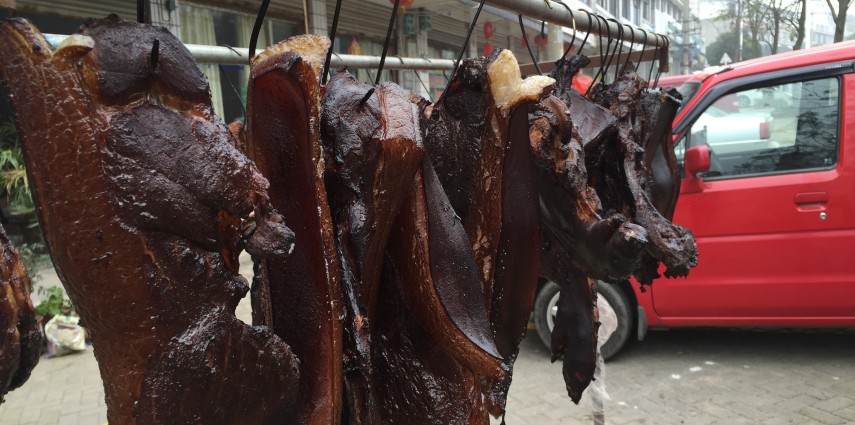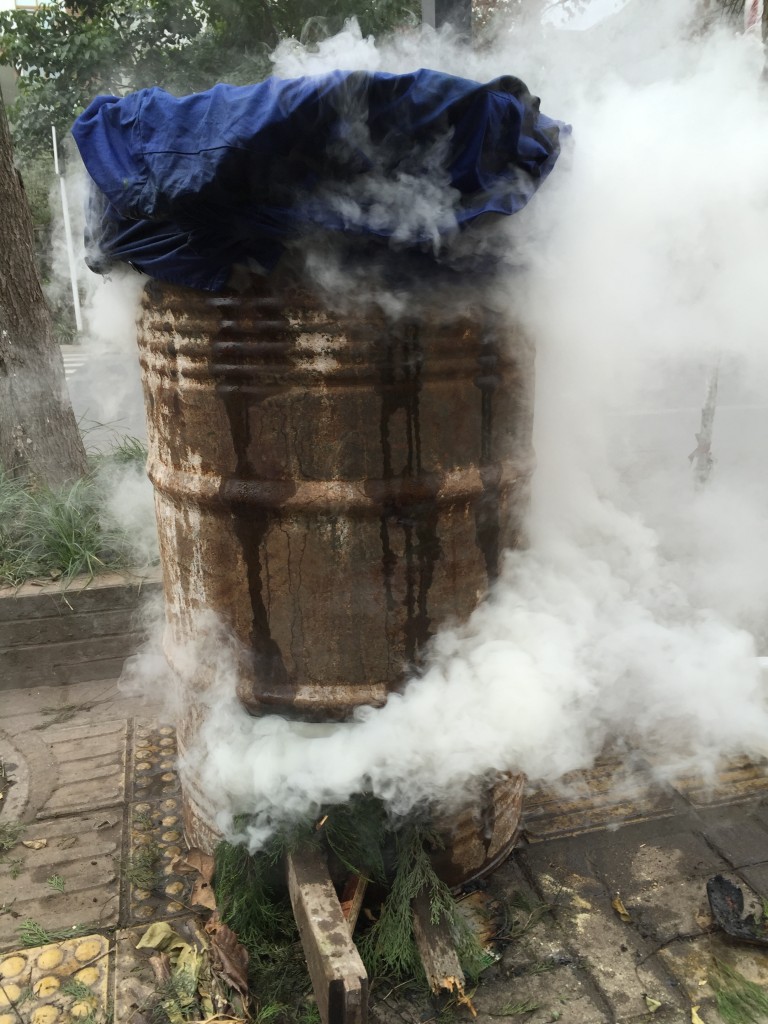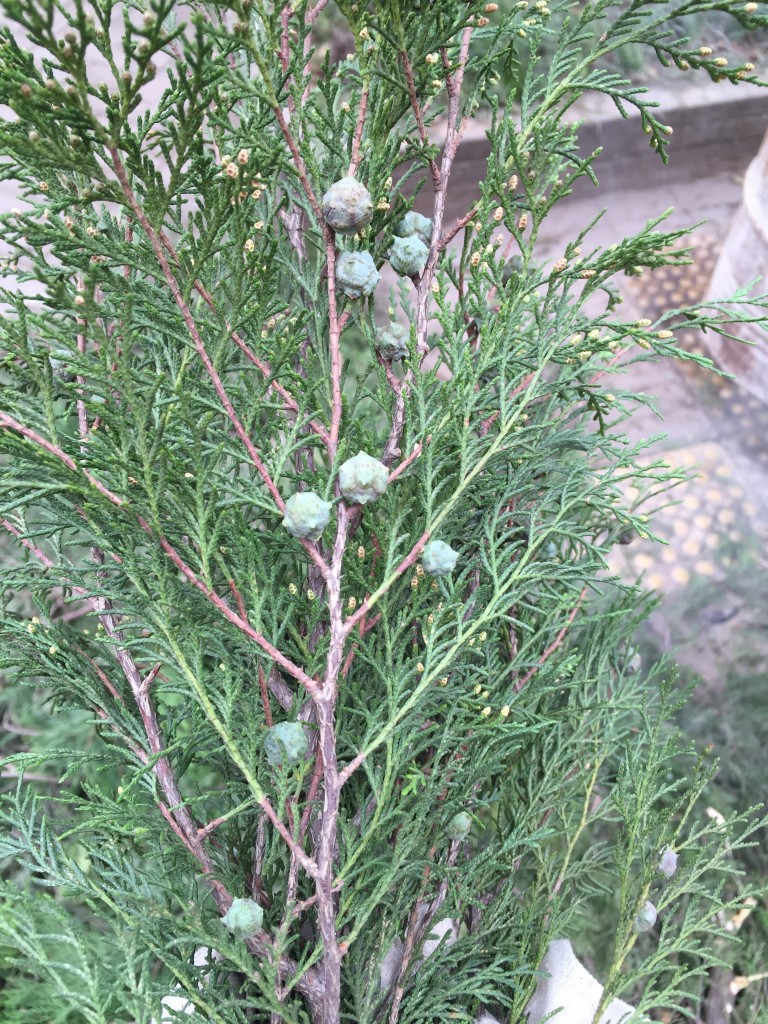My obsession with a smoked meat, and my quest to learn the secrets
We headed out to Longquan (our favorite Chengdu suburb) to learn from the locals about our favorite winter time tradition – making Larou (腊肉). Larou is pork belly that is cured, smoked, then hung to dry. It is a salty, smoky delicious tradition that graces balconies and clothes lines across the province throughout the winter months leading up to the Spring Festival. At the family feasts of the Chinese New Year, smoked pork (as well as smoked, duck, fish and sausages) are boiled or steamed and sliced thinly and served as a meat platter. Larou can also be fried with garlic shoots or cauliflower and stewed with green peas.

Larou and a side of sausages
I first heard of Larou in 2010, when I had just arrived in China and a visiting friend, who had met a Sichuanese local in Beijing, regaled me with the stories he had heard of the smoked meat and his memorable first tasting. It was the fall and I had never heard of this nor seen it anywhere and was confused and keen to try it. And so I set out in search for Larou, and you could say I never really looked back. This melt-in-your mouth smoky, fatty ham was unlike any smoked meat I had tried before, and so as my love affair progressed I resolved to learn the secrets of procuring my new favorite charcuterie. This year I finally made good on my promise to myself.
Making Larou is 3 part process, and will take at least 10 days to complete all stages be able to taste the meats of your labor.
Curing
First, you must select the right meat. Fatty (to your desired level) pork belly is what is traditionally used. We bought large pork belly slabs and cut them into strips around 3 inches wide and a foot, or a foot and a half long. We also purchased long ribs, and cut them into pairs, to make them easier to hang. La ribs are not the classic version of Larou, but are an incredible variation and something one can rarely find in restaurants or outside the homes of their local friends.

Ribs in their dry salty rub
Once the meat is cut (theoretically any shape and size can work, butconsistency helps for the later stages) we go about curing it. A mixture of salt, Sichuan Peppercorn and a blend of 13 spice powder which includes cinnamon, star anise, cardamom, fennel, orange peel and a few other things, is heated in a large wok until the salt is toasted and turns yellow. The fragrant mixture is then liberally applied to the meat so that no part is left exposed. After gently shaking each piece to remove the excess, the pieces are placed into a large bucket.
The meat will sit in the loosely covered bucket for 3-4 days, and needs to be turned/flipped over every day 1-2 times. After it has been sufficiently cured, it is hung to dry for an additional 3-4 days to prepare it for smoking.
*the temperatures in Sichuan at this time of year make it ideal for hanging and drying meat without it spoiling, and is why it is done at this time of year. In hotter climates the meat would spoil, and in colder ones it could freeze.
Smoking
- The smoke barrell
- Cypress boughs
When the meat has sufficiently dried. we get to the fun part- the smoking! Unlike many western cured meats which are cold smoked using hard woods, Larou is smoked with the boughs of a cypress tree. Traditionally, and still in many rural areas the meat will simply be hung over an open fire, far enough to not be cooked by the flames, but close enough to embrace the rising smoke. To be more efficient (as many families do now) we used a metal barrel to trap the smoke and speed up the process. We created racks and hung 2 layers of meat and ribs inside the barrel, and placed a cover and a wet towel over the top. A window had been cut at the bottom of the barrel to allow us to continue feeding the fire. The fire must be continually monitored and fed to keep the smoke going full power, but avoid the boughs catching flame. The peels of sugar canes, pomelos or oranges can also be added to the fire for additional flavor. Depending on the heat from the fire, intensity of the smoke, and desired effect, each batch is smoked for 2-4 hours until the meat turns a bronzey red or yellow and looks sufficiently dried. One of my favorite parts of Chinese cooking is its suspicion and disregard of recipes and specifications – instead, ingredient amounts and cooking times are up to the cook and the results ultimately depend on how good his/her ‘kung-fu’ is.
Drying
Once the meat has been smoked it is hung to dry for an additional 3 or so days. Since the purpose of smoking meat is to preserve it through the winter (not just to create indulgent flavors), pieces that aren’t used right away are usually frozen for later consumption.

Larou just hanging out
Eating
While Larou can be consumed in many ways, and has been incorporated into many traditional and non-traditional dishes (smoked meat sandwiches anyone….?) it’s best appreciated as is. Simply boil or steam until heated through and slice thinly, then serve as part of your Spring Festival Feast or avant-garde charcuterie board. Dig in!

Sausages and larou platter
If you join us during the winter, we will be happy to sample some smoked meats or sausages along the way.



